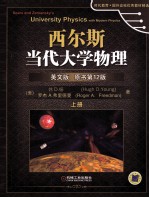图书介绍
西尔斯当代大学物理 英文版 原书12版 上pdf电子书版本下载

- (美)扬,(美)弗里德曼著 著
- 出版社: 北京:机械工业出版社
- ISBN:7111326755
- 出版时间:2011
- 标注页数:708页
- 文件大小:384MB
- 文件页数:729页
- 主题词:
PDF下载
下载说明
西尔斯当代大学物理 英文版 原书12版 上PDF格式电子书版下载
下载的文件为RAR压缩包。需要使用解压软件进行解压得到PDF格式图书。建议使用BT下载工具Free Download Manager进行下载,简称FDM(免费,没有广告,支持多平台)。本站资源全部打包为BT种子。所以需要使用专业的BT下载软件进行下载。如 BitComet qBittorrent uTorrent等BT下载工具。迅雷目前由于本站不是热门资源。不推荐使用!后期资源热门了。安装了迅雷也可以迅雷进行下载!
(文件页数 要大于 标注页数,上中下等多册电子书除外)
注意:本站所有压缩包均有解压码: 点击下载压缩包解压工具
图书目录
MECHANICS 1
1UNITS,PHYSICAL QUANTITIES,AND VECTORS 1
1.1 The Nature of Physics 2
1.2 Solving Physics Problems 2
1.3 Standards and Units 4
1.4 Unit Consistency and Conversions 6
1.5 Uncertainty and Signifi. cant Figures 8
1.6 Estimates and Orders of Magnitude 10
1.7 Vectors and Vector Addition 11
1.8 Components of Vectors 15
1.9 Unit Vectors 20
1.10 Products of Vectors 21
Summary/Key Terms 27
Questions/Exercises/Problems 28
2MOTION ALONG A STRAIGHT LINE 36
2.1 Displacement,Time,and Average Velocity 37
2.2 Instantaneous Velocity 39
2.3 Average and Instantaneous Acceleration 43
2.4 Motion with Constant Acceleration 47
2.5 Freely Falling Bodies 53
2.6 Velocity and Position by Integration 57
Summary/Key Terms 60
Questions/Exercises/Problems 61
3MOTION IN TWO OR THREE DIMENSIONS 71
3.1 Position and Velocity Vectors 72
3.2 The Acceleration Vector 74
3.3 Projectile Motion 79
3.4 Motion in a Circle 87
3.5 Relative Velocity 91
Summary/Key Terms 96
Questions/Exercises/Problems 97
4 NEWTON’S LAWS OF MOTION 107
4.1 Force and Interactions 108
4.2 Newton’s First Law 111
4.3 Newton’ s Second Law 115
4.4 Mass and Weight 120
4.5 Newton’ s Third Law 123
4.6 Free-Body Diagrams 126
Summary/Key Terms 129
Questions/Exercises/Problems 130
5 APPLYING NEWTON’S LAWS 136
5.1 Using Newton’s First Law:Particles in Equilibrium 136
5.2 Using Newton’s Second Law:Dynamics of Particles 142
5.3 Frictional Forces 149
5.4 Dynamics of Circular Motion 158
5.5 The Fundamental Forces of Nature 163
Summary/Key Terms 165
Questions/Exercises/Problems 166
6 WORK AND KINETIC ENERGY 181
6.1 Work 182
6.2 Kinetic Energy and the Work-Energy Theorem 186
6.3 Work and Energy with Varying Forces 192
6.4 Power 199
Summary/Key Terms 202
Questions/Exercises/Problems 203
7POTENTIAL ENERGY AND ENERGY CONSERVATION 213
7.1 Gravitational Potential Energy 214
7.2 Elastic Potential Energy 222
7.3 Conservative and Nonconservative Forces 229
7.4 Force and Potential Energy 232
7.5 Energy Diagrams 235
Summary/Key Terms 237
Questions/Exercises/Problems 238
8MOMENTUM,IMPULSE,AND COLLISIONS 247
8.1 Momentum and Impulse 247
8.2 Conservation of Momentum 253
8.3 Momentum Conservation and Collisions 257
8.4 Elastic Collisions 262
8.5 Center of Mass 266
8.6 Rocket Propulsion 270
Summary/Key Terms 273
Questions/Exercises/Problems 274
9 ROTATION OF RIGID BODIES 285
9.1 Angular Velocity and Acceleration 285
9.2 Rotation with Constant Angular Acceleration 290
9.3 Relating Linear and Angular Kinematics 293
9.4 Energy in Rotational Motion 296
9.5 Parallel-Axis Theorem 301
9.6 Moment-of-Inertia Calculations 303
Summary/Key Terms 306
Questions/Exercises/Problems 307
10 DYNAMICS OF ROTATIONAL MOTION 316
10.1 Torque 316
10.2 Torque and Angular Acceleration for a Rigid Body 319
10.3 Rigid-Body Rotation About a Moving Axis 323
10.4 Work and Power in Rotational Motion 329
10.5 Angular Momentum 331
10.6 Conservation of Angular Momentum 333
10.7 Gyroscopes and Precession 337
Summary/Key Terms 341
Questions/Exercises/Problems 343
11 EQUILIBRIUM AND ELASTICITY 354
11.1 Conditions for Equilibrium 355
11.2 Center of Gravity 355
11.3 Solving Rigid-Body Equilibrium Problems 358
11.4 Stress,Strain,and Elastic Moduli 363
11.5 Elasticity and Plasticity 368
Summary/Key Terms 370
Questions/Exercises/Problems 371
12 GRAVITATION 383
12.1 Newton’s Law of Gravitation 383
12.2 Weight 388
12.3 Gravitational Potential Energy 390
12.4 The Motion of Satellites 393
12.5 Kepler’ s Laws and the Motion of Planets 396
12.6 Spherical Mass Distributions 400
12.7 Apparent Weight and the Earth’ s Rotation 403
12.8 Black Holes 405
Summary/Key Terms 410
Questions/Exercises/Problems 411
13 PERIODIC MOTION 419
13.1 Describing Oscillation 419
13.2 Simple Harmonic Motion 421
13.3 Energy in Simple Harmonic Motion 428
13.4 Applications of Simple Harmonic Motion 432
13.5 The Simple Pendulum 436
13.6 The Physical Pendulum 438
13.7 Damped Oscillations 440
13.8 Forced Oscillations and Resonance 442
Summary/Key Terms 445
Questions/Exercises/Problems 447
14 FLUID MECHANICS 456
14.1 Density 456
14.2 Pressure in a Fluid 458
14.3 Buoyancy 463
14.4 Fluid Flow 466
14.5 Bernoulli’ s Equation 468
14.6 Viscosity and Turbulence 472
Summary/Key Terms 476
Questions/Exercises/Problems 477
WAVES/ACOUSTICS 487
15 MECHANICAL WAVES 487
15.1 Types of Mechanical Waves 488
15.2 Periodic Waves 489
15.3 Mathematical Description of a Wave 492
15.4 Speed of a Transverse Wave 498
15.5 Energy in Wave Motion 502
15.6 Wave Interference,Boundary Conditions,and Superposition 505
15.7 Standing Waves on a String 507
15.8 Normal Modes of a String 511
Summary/Key Terms 516
Questions/Exercises/Problems 518
16 SOUND AND HEARING 527
16.1 Sound Waves 527
16.2 Speed of Sound Waves 532
16.3 Sound Intensity 537
16.4 Standing Sound Waves and Normal Modes 541
16.5 Resonance and Sound 546
16.6 Interference of Waves 548
16.7 Beats 550
16.8 The Doppler Effect 552
16.9 Shock Waves 558
Summary/Key Terms 561
Questions/Exercises/Problems 563
THERMODYNAMICS 570
17 TEMPERATURE AND HEAT 570
17.1 Temperature and Thermal Equilibrium 571
17.2 Thermometers and Temperature Scales 572
17.3 Gas Thermometers and the Kelvin Scale 574
17.4 Thermal Expansion 576
17.5 Quantity of Heat 582
17.6 Calorimetry and Phase Changes 586
17.7 Mechanisms of Heat Transfer 591
Summary/Key Terms 598
Questions/Exercises/Problems 600
18THERMAL PROPERTIES OF MATTER 610
18.1 Equations of State 611
18.2 Molecular Properties of Matter 617
18.3 Kinetic-Molecular Model of an Ideal Gas 619
18.4 Heat Capacities 626
18.5 Molecular Speeds 629
18.6 Phases of Matter 631
Summary/Key Terms 635
Questions/Exercises/Problems 637
19THE FIRST LAW OF THERMODYNAMICS 646
19.1 Thermodynamic Systems 646
19.2 Work Done During Volume Changes 647
19.3 Paths Between Thermodynamic States 650
19.4 Internal Energy and the First Law of Thermodynamics 651
19.5 Kinds of Thermodynamic Processes 656
19.6 Internal Energy of an Ideal Gas 658
19.7 Heat Capacities of an Ideal Gas 659
19.8 Adiabatic Processes for an Ideal Gas 662
Summary/Key Terms 665
Questions/Exercises/Problems 667
20THE SECOND LAW OF THERMODYNAMICS 673
20.1 Directions of Thermodynamic Processes 673
20.2 Heat Engines 675
20.3 Internal-Combustion Engines 678
20.4 Refrigerators 680
20.5 The Second Law of Thermodynamics 682
20.6 The Carnot Cycle 684
20.7 Entropy 690
20.8 Microscopic Interpretation of Entropy 697
Summary/Key Terms 700
Questions/Exercises/Problems 702